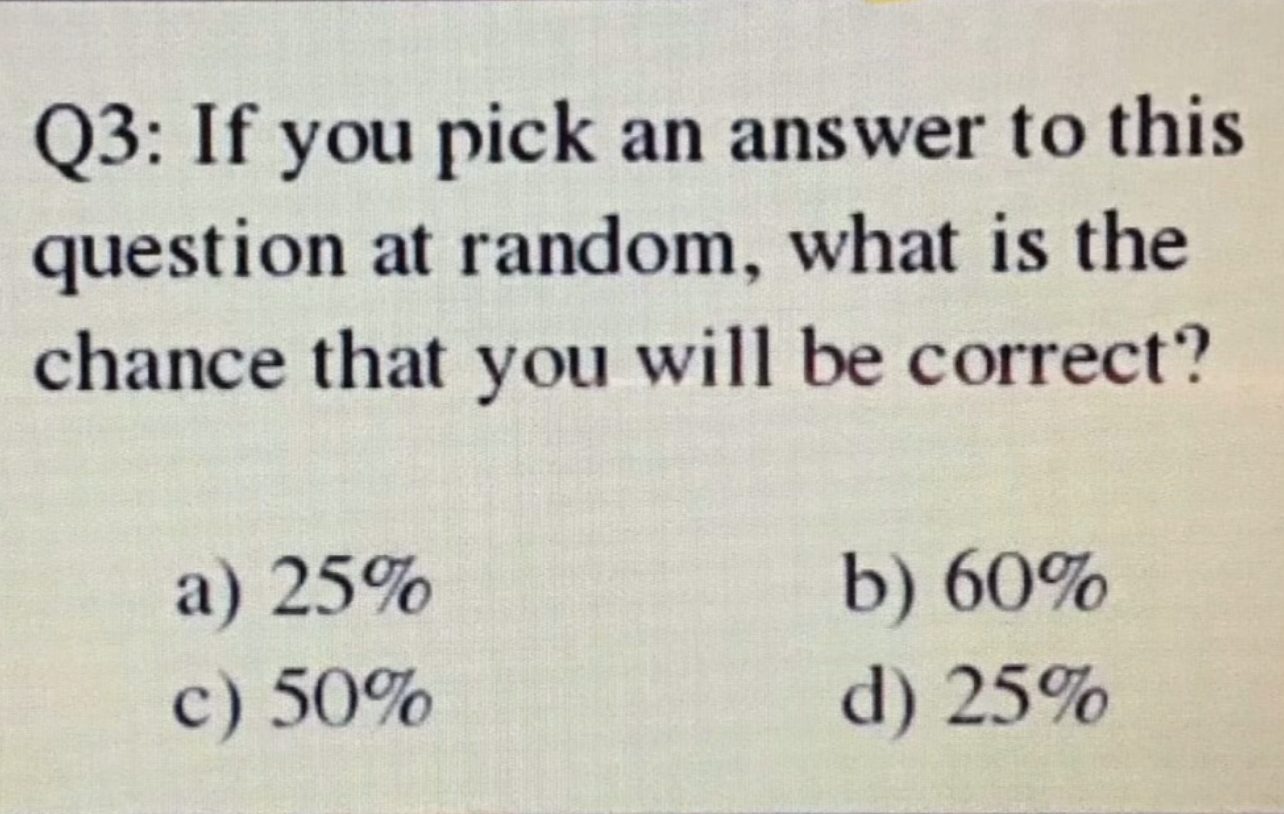If you're choosing the answer, then there is 100% chance of being correct. Since none of these answers is 100%, the chance is 0%.
Science Memes
Welcome to c/science_memes @ Mander.xyz!
A place for majestic STEMLORD peacocking, as well as memes about the realities of working in a lab.

Rules
- Don't throw mud. Behave like an intellectual and remember the human.
- Keep it rooted (on topic).
- No spam.
- Infographics welcome, get schooled.
This is a science community. We use the Dawkins definition of meme.
Research Committee
Other Mander Communities
Science and Research
Biology and Life Sciences
- [email protected]
- [email protected]
- [email protected]
- [email protected]
- [email protected]
- [email protected]
- [email protected]
- [email protected]
- [email protected]
- [email protected]
- [email protected]
- [email protected]
- [email protected]
- [email protected]
- [email protected]
- [email protected]
- [email protected]
- [email protected]
- [email protected]
- [email protected]
- [email protected]
- [email protected]
- [email protected]
- [email protected]
- !reptiles and [email protected]
Physical Sciences
- [email protected]
- [email protected]
- [email protected]
- [email protected]
- [email protected]
- [email protected]
- [email protected]
- [email protected]
- [email protected]
Humanities and Social Sciences
Practical and Applied Sciences
- !exercise-and [email protected]
- [email protected]
- !self [email protected]
- [email protected]
- [email protected]
- [email protected]
Memes
Miscellaneous
That logic would only hold if I wasn't dumb as rocks.
🤯
It's annoying that 25% appears twice. How about these answers:
a) 100%
b) 75%
c) 50%
d) 0%
Thanks for making me laugh all alone in my car before heading in to work. I wish I could give you an award. Cheers!
This is a conundrum wrapped in a turducken, swaddled in nesting dolls.
lol chill out there buddy it is only self-referential once. maybe twice.
I'm not certain, I think it's an infinite loop.
I.E. If the answer is 25%, you have a 50% chance, if the answer is 50%, you have a 25% chance, if the answer is 25%, you have a 50% chance...
The only way out is to choose 60% to accept defeat
Haha, I think they should have made that option 0%, to further the paradox
What's the correct value if the answer is not picked at random but the test takers can choose freely?
All answers are correct then.
It's probably graded by a computer, and a) or d) is a fake answer, since the automated system doesn't support multiple right answers.
I'm going to go with 25% chance if picking random, and a 50% chance if picking between a) and d).
If it's graded by a human, the correct answer is f) + u)
Many systems do allow multiple correct answers.
42
Damn hitchhikers.
But what's the question?
how many roads must a man walk down?
The question is malformed and the correct answer isn't listed in the multiple choices. Therefore the correct answer is 0%
If only one of the 4 options said 25% would it still be malformed#
33% innit
iis
It is 33% if the answer itself is randomly chosen from 25%, 50%, and 60%. Then you have:
If the answer is 25%: A 1/2 chance of guessing right
If the answer is 50%: A 1/4 chance of guessing right
If the answer is 60%: A 1/4 chance of guessing right
And 1/3*1/2 + 1/3*1/4 + 1/3*1/4 = 1/3, or 33.333...% chance
If the answer is randomly chosen from A, B, C, and D (With A or D being picked meaning D or A are also good, so 25% has a 50% chance of being the answer) then your probability of being right changes to 37.5%.
This would hold up if the question were less purposely obtuse, like asking "What would be the probability of answering the following question correctly if guessing from A, B, C and D randomly, if its answer were also chosen from A, B, C and D at random?", with the choices being something like "A: A or D, B: B, C: C, D: A or D"
B.
This is a multiple choice test. Once you eliminate three answers, you pick the fourth answer and move on to the next question. It can't be A, C, or D, for reasons that I understand. There's a non-zero chance that it's B for a reason that I don't understand.
If there is no correct answer, then there's no point hemming and hawing about it.
B. Final answer.
This is a self-referential paradox — a classic logic puzzle designed to be tricky. Let’s break it down:
Step-by-step analysis:
-
How many choices? There are 4 possible answers, so if we pick one randomly, the chance of picking any specific one is 1 in 4 = 25%.
-
How many answers say “25%”? Two.
-
That means the probability of randomly choosing an answer that says “25%” is 2 in 4 = 50%.
-
But if the correct answer is 50%, then only one option says “50%” — which is (c). So the probability of picking it at random is 1 in 4 = 25%, contradicting the idea that 50% is correct.
-
If the correct answer is 25%, then two options say that — a and d. So the chance of picking one of those at random is 50%, not 25% — again a contradiction.
-
Similarly, if 60% is correct (only one option), then the chance of picking it randomly is 25%, which again makes it incorrect.
Conclusion: Any choice leads to a contradiction. This is a self-referential paradox, meaning the question breaks logical consistency. There is no consistent correct answer.
Chatgpt ass answer lmao
haha yeah, I knew it at the "let's break it down:"
I was like.. I know this voice....
"Conclusion:" was the final nail in the coffin
Got it right though
Paradoxes aside, if you're given multiple choices without the guarantee that any of them are correct, you can't assign a chance of picking the right one at random anyway.
